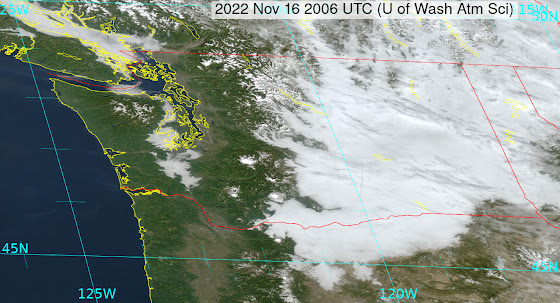My podcast talk starts with an exceptional forecast for this time of the year: this weekend will be dry and sunny, and I expect the weather on Thanksgiving Day to be excellent.
But a turn to cloudy, wet conditions looms after that...
And then I discuss the meteorology of the Columbia Basin, describing the cold, cloudy weather that fills this topographic "bowl" during the winter season.
To illustrate, take a look at the visible satellite image from Wednesday.








The MSM prophets of doom here in Portland have started up (right on cue), regarding the extended dry streak here in November. "Eleven straight days of no rain, the record is THIRTEEN!!!" It never ends.
ReplyDeleteAlmost like there frequent instances of unusual weather, perhaps reflecting broader trends in climate. As if the climate was, I don't know, changing?
DeleteHow much weather do you need before you consider it climate?
DeleteFair question, and to be honest I don't have a specific number in mind. There is of course a risk in treating any datum as part of a larger trend, so I wouldn't lean too heavily on this specific prolonged dry spell to make any points about climate.
DeleteHowever, by most accounts extremes (as presently defined) will become more common (and thus, less extreme) as the climate continues to warm. Decent read here: https://www.worldweatherattribution.org/trends-in-weather-extremes-february-2018/
For whatever it's worth, I really wasn't trying to be argumentative so if my comment off as anything other than a bit of ribbing I apologize.
It's all good.
DeleteI live in the Columbia Basin (Wenatchee). I built an Arduino based environment sensor where I measure temperature, barometric pressure, relative humidity, light intensity, and airborne particulates. From this data, I calculate heat index, dew point, and air quality index. All this data gets displayed in a table on a TFT display.
ReplyDeleteI recently added a feature to the sensor where I calculate formation of dew or frost. It's simply a series of "If" statements that compares the ambient temperature to the dew point and indicates whether dew or frost will form.
Here's my question: I read something that said one of the reasons it's important to know the dew point is that the ambient temperature cannot go below the dew point, and it's therefore useful to predict overnight low temperatures. Is it true that ambient temperature cannot go below the dew point temperature? I can see where the concept of latent heat would apply where heat transfer would occur with no change in temperature.
I'm hoping one of the real atmospheric science people here can educate me on this topic and explain the physics.
Thank you.
I'm kind of concerned about the lack of rain, we had a good dose but then nothing, dig a hole 6" to 1 foot down still bone dry..not good
ReplyDeleteThis is what the majority of the Public wants. After 6 months of just about all sunny days, they demand more sunny days. There doesn't seem to be this connection between Endless Sun/Summer and drought. Hopefully the precipitation all evens out through the rest of the rainy season and the snow pack is adequate.
DeleteWhat are you really concerned about? Do you honestly think it's not going to rain for the rest of the winter? After this week, that's all it's going to do. This isn't California, take it easy. Enjoy the sun.
DeleteAt this point with the weather, bets are off.
Delete